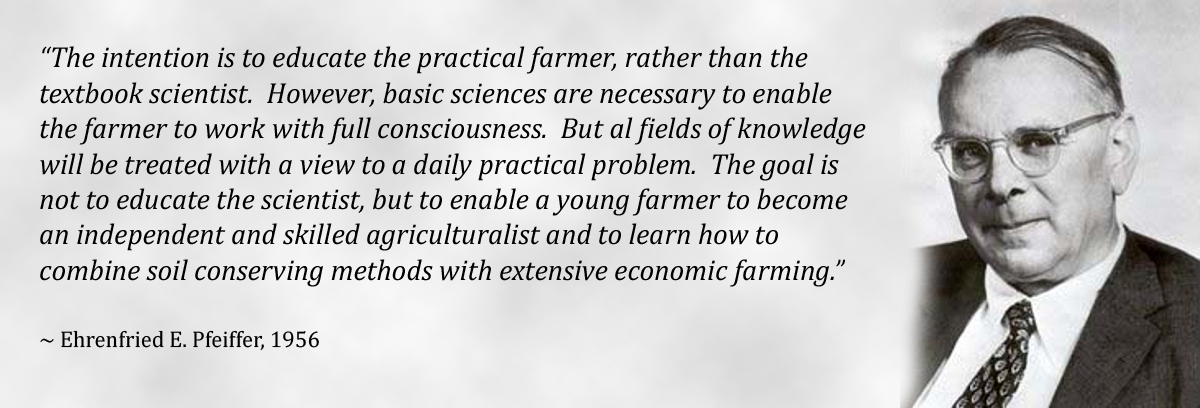How to Grow Health by Building the Soil
By Ehrenfried E. Pfeiffer
Biodynamics is both a concept and a practice. It combines the study and application of those forces and energies that promote life and growth. The very word is significant –
BIOS – LIFE: DYNAMIS - ENERGY, FORCE
Here we deal with biodynamic agriculture, its meaning and its objectives. This is significant not only to the farmer but to everyone, for none of us can long afford to ignore the deep affinities that relate us to the soil.
It all started during the early twenties when a few European farmers began to worry about the decline of feeding values of their crops, of the viability of seeds; the lack of stability of inherited properties of seed strains. At the turn of the century, it was not unusual for alfalfa to last 7, 9 or even 30 years before it failed. Clover lasted many years before symptoms of soil exhaustion became apparent. It was not unusual for a farmer to use the same wheat, rye and oats again and again as seed (of course, after cleaning, etc.) for many generations. Today he plows his alfalfa field after four years, his clover field after two years, and every few years he has to obtain new seed varieties or strains from the experimental station or seed house.
One of the pertinent problems that confronted these farms was te decline in the baking quality of wheat and flour. These were not back-woods farmers but men with well-run farms ranging from a few acres to over 40,000 acres. A real dilemma posed itself – what could be done to arrest the decline in soils, the loss of fertility, the degenerative symptoms of seed, the increase of pests, fungi and insects. Paradoxically, it seemed that under the impact of intensive fertilization with mineral fertilizers the problems became manifold even though there was a 25% quantity increase in yield per acres. Significantly, to produce this 25% increase cost four times the previous effort. Far-sighted farmers, growers and gardeners, along with a few soil scientists and agronomists grouped together to discuss the problem. They were unable to obtain satisfactory answers from the orthodox representatives of agriculture whose advise was to use nitrogen, phosphate, and potash as fertilizer because these mineral elements were taken away with each crop and needed to be replenished. The more, the better, they contended – with lime to thought of as a universal panacea.

Finally the group sought advice from outside in the person of Rudolf Steiner. At first glance it appears unusual that council was sought from the Austrian-born philosopher, who had received his Ph.D. at the University of Rostock on problems of a Philosophy of Spiritual Activity. Rudolf Steiner had achieved recognition as an editor of Goethe’s scientific writings and had worked for many years at the Goethe Archives in Weimar, Germany. When the group came to him he had already built his own school – the Goetheanum in Dornach, Switzerland. There was a vital need for new ideas and a new approach. The group felt strongly that what was needed was a training of observation and mind that could be applied practically to the very grass roots of material existence.
Startling at first, the answer grew in due time to what is now Biodynamic Farming and Gardening. Rudolf Steiner pointed out the need for recognizing the total environment of the plant. A growing plant is more than matter and photosynthesis, there are many environmental factors that foster or inhibit. He further stated that there are trace minerals that foster or inhibit. He further stated that there are trace minerals, influences of one plant upon another, growth promoting factors and substances. The integration of these factors leads to the organic whole, which intimately means health, growth, nutrition value and duration. The basic reward is the maintenance of fertility instead of its loss and the dynamic relationships are as important as the material-substantial. These dynamic forces need to be harnessed just as the proper soil food needs to be applied. One without the other does not support the whole. All this became intensely meaningful to the group that heard Dr. Steiner. It has been put to the test, confirmed by trial and error, evolved by practice and experiment, so that today the entire method stands before the world as experience – teachable and demonstrable.
Why then has this method not become universal? Perhaps because it demands active cooperation by the farmer. At times it asks the seemingly improbable that is not to do something which all the neighbours are doing but to steer away from worn-out habits and be independent; to make decisions rather than simply follow methods which are external to the problem. The farmer’s attitude toward difficulties – crop failure, a disease, a pest, has often been summed up by “What should I throw on to correct the situation.” The need is not to “throw on” but to change the method of cultivation and crop rotation, to avoid monoculture, to introduce biological control, in short things which cannot simply be purchased but must be thought out. The farmer must plan, make decisions and carry them out. There is very little to buy in the biodynamic method, but lots to do. This method was introduced in America during the early thirties, long before there was any talk of “Organic Farming and Gardening.”

Do it yourself is the heart of the biodynamic approach. You make your own compost heap, treating it with the right kind of microlife and dynamic elements (BD Compost Starter and BD Preparations) so as to produce humus which is immediately available with all its absorbed and retained nutrients. The soil is built by proper cultivation form the surface and a gradual descending deeper. No bulldozer methods here. It is important to introduce long-range planning and crop rotation, alternating exhausting with restoring crops. With our growing population curve the basic need of the soil to have its productivity restored can hardly be overestimated. Plants actually like and dislike one another, depending on the finer compounds, inhibitors or even promoters which they exchange through the soil from root to root, or even by way of decaying leaf mold or pollen. There is quite a bit of knowledge about these influences which can be packed into a useful application of synergistic processes. To consider all this requires activity on the part of the farmer.
The result of the application of these points of view, that is, the biodynamic concept or science, is that plants grow better in a more harmonious, balanced natural environment. Plants can be forced to grow fast and bulky. As long as the farmer has to aim for the better prices of an earlier market, he wants fast-growing plants, to be harvested before the peak of the market. Payment is for quantity, bushel or weight per acre. The emphasis is only on bulk. A plant forced to grow bulk is not always the healthiest, most resistant or most nutritious. In human beings it is often the bulky that are susceptible to early breakdown or degenerative disease rather than the lean, sinewy. So in meats for the consumer – the leaner product contains more nutrition, more protein, than the fat, and is less dangerous. Many of the insecticide residues, DDT, for instance, accumulate in the fat.
A slower-growing plant, especially when it grows in a well-balanced, mature humus soil, grows more roots, grows deeper roots, assimilates more nutrients and therefore is able to grow a better balanced system of carbohydrates, proteins and minerals in its own body. A better distribution of vitamins, enzymes too, is the result. This food then is preferable as nutrition because nature has been given a chance to grow quality values. All these factors which center about quality and health culminate in one concept: the balanced organism. What then is balance? It is best explained by its opposite: disturbance of balance, excess or deficiency. A plant which grows too fast and is a lush green because of an excess of nitrogen fertilizer is not able to utilize other mineral nutrients properly. It may show potash deficiency even though it had all the potash in the soil, and in its cells, which is necessary. This is not an absolute but a relative deficiency, an inability to utilize potash. And so, conversely, a potash deficiency results in an inability to utilize nitrogen, no matter how much or little is available. In the human realm, we have similar problems of balance: someone who has an excess of vitamin A simulates his biochemical process in a one-sided way: then he may show symptoms similar to those of a B complex or Vitamin C deficiency, even though he may have gotten his proper daily requirements of these other vitamins. The balance has been disturbed. The biodynamic concept rests on the knowledge of balance and gives it primacy. Quality product is its aim. Biological or physiological efficiency is the result. This implies building up and maintaining health. In the practical application of these principles, surprising results have been obtained. One of them is that smaller doses of mineral elements in combination with sound soil and humus=building practice produces better results than does excessive amounts of one or the other mineral fertilizers. The protein quality expressed in a proper amino acid balance is improved.
Crops grown according to the biodynamic principles weather droughts better than other crops. The protein content and amino acid balance are above the level for the area and climate in which they are grown. The baking value of such wheat, for instance, is improved. Many of the grains grown ordinarily are lysine deficient: biodynamic grains always show a relatively high lysine content. Lysine is an important amino acid, for it cannot be synthesized by the human being. Where lysine is deficient, there will be a poor utilization of all other amino acids.
In the human body a peculiar biochemical physiological mechanism exists. All proteins are broken down into their component amino acids during the due course of digestion. But the villi of the intestines can absorb only a certain amino acid balance, whereupon the nutrients are transported to the liver and used for the body’s own synthesis. If the proper amino acid balance in the digested food chime does not exist, the digestive glands secrete the missing amino acids to restore the balance. This means that the body sacrifices its own substance to enable it to utilize properly the digested but imbalanced food. It is therefore necessary, for proper nutrition to grow a well-balanced food to start with, beginning with the soil. The biochemical data illustrating these relationships has been published in some areas in recent years and the facts are known, but have not yet entered the textbooks.
The foresight of a method, learned from painstaking observations of nature’s laws governing life and growth, condensed into a biodynamic concept of interaction between matter and energy, as demonstrated by the late Rudolf Steiner 30 or 40 years before all the detailed facts became known, is an example of how a practical philosophy read from the underlying principles of nature can be made useful. Living concepts have led to new practices. This is what our troubled time needs more than anything else – only then will we be able to look into a better future.
 Ehrenfried Pfeiffer began work with Rudolf Steiner in the early 1920’s. After Steiner's death in 1925, Pfeiffer worked in the private research laboratory at the Goetheanum in Dornach, (Switzerland). He became manager and director of the 800-acre experimental biodynamic Loverendale farm in Domburg, Netherlands. This farm was set up to carry out some of the agricultural studies of the Goetheanum laboratory. The work of testing and developing Rudolf Steiner's Agriculture Course of 1924 was an international enterprise coordinated by Pfeiffer at the Natural Science Section of the Goetheanum. Ehrenfried Pfeiffer began work with Rudolf Steiner in the early 1920’s. After Steiner's death in 1925, Pfeiffer worked in the private research laboratory at the Goetheanum in Dornach, (Switzerland). He became manager and director of the 800-acre experimental biodynamic Loverendale farm in Domburg, Netherlands. This farm was set up to carry out some of the agricultural studies of the Goetheanum laboratory. The work of testing and developing Rudolf Steiner's Agriculture Course of 1924 was an international enterprise coordinated by Pfeiffer at the Natural Science Section of the Goetheanum.
Pfeiffer’s most influential book 'Bio-Dynamic Farming and Gardening' was published in 1938.
Pfeiffer first visited the U.S. in 1933 to lecture about biodynamics at a farm in Spring Valley, New York. While in New York, Pfeiffer met J.I. Rodale, founder of Organic Gardening and Farming magazine, and of the organic movement in the USA. This relationship gave biodynamics a little-known place in the history of the North American organic movement.
Ehrenfried E. Pfeiffer can look back upon 37 years of personal participation – soils, farming, biodynamic agriculture. He has acted as a consultant all over the world and has successfully managed his own farms.
For additional information on Ehrenfried E. Pfeiffer and his research, visit The Pfeiffer Center.
The Pfeiffer Center practices, teaches and promotes biodynamics through courses, workshops, and internships for all levels of experience and interest. The ongoing work of developing a biodynamic farm individuality in the northern suburbs of New York City is the foundation for our educational programming.
|


![]()



 Ehrenfried Pfeiffer began work with Rudolf Steiner in the early 1920’s. After Steiner's death in 1925, Pfeiffer worked in the private research laboratory at the
Ehrenfried Pfeiffer began work with Rudolf Steiner in the early 1920’s. After Steiner's death in 1925, Pfeiffer worked in the private research laboratory at the